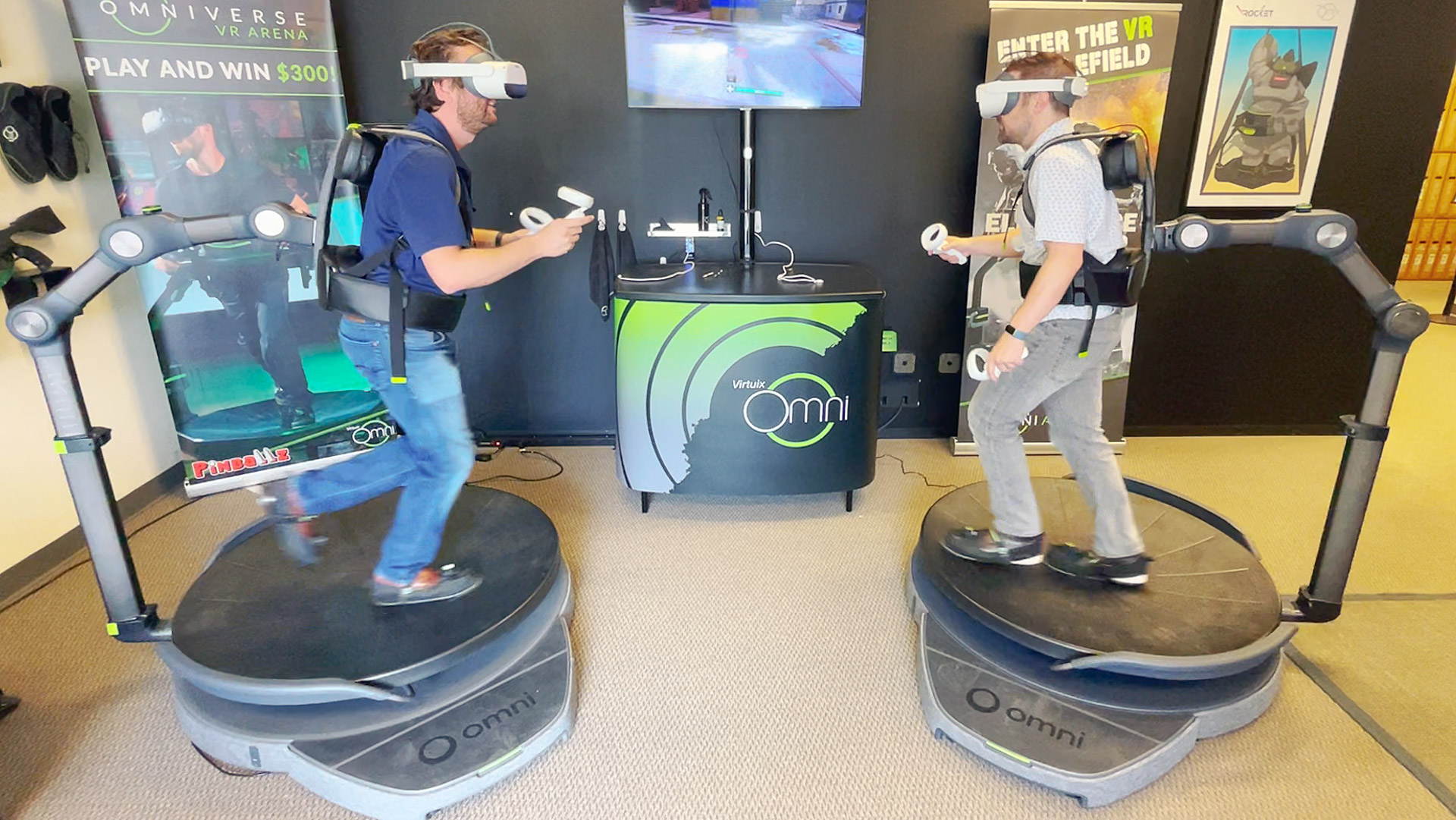As far as VR treadmills go, Virtuix is the OG. While the company had set out to make a consumer VR treadmill a decade ago, market realities pushed the company into the out-of-home VR attraction space. But after all these years the company remains dead-set on selling a VR treadmill to consumers, and this time around it’s taking an all-in-one approach with the new Virtuix Omni One. I visited the company’s Austin, Texas headquarters to try it for myself.
The Virtuix Omni Backstory
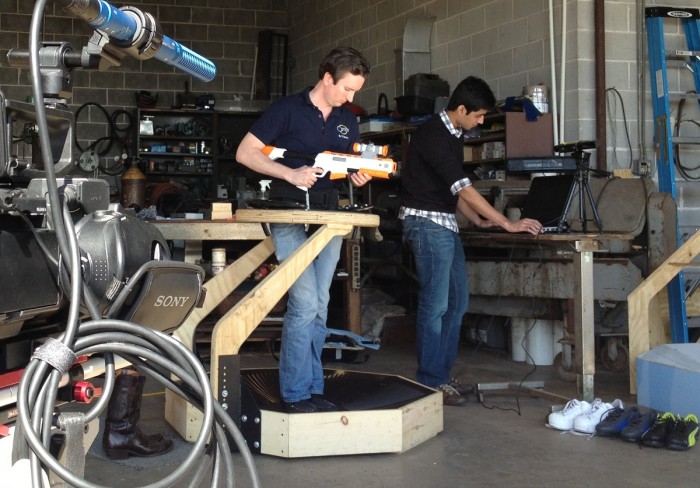
The original Virtuix Omni treadmill started life way back in 2013 as wooden prototype built by a small group led by CEO Jan Goetgeluk. Thus the core idea was conceived a full three years before the first wave of consumer VR headsets appeared on the market in 2016.
The idea itself is simple. What if you had a treadmill on which you could run in any direction? With such a treadmill and a VR headset on your head, you could move your body and feel like you were really moving through the virtual world.
The execution of this idea, however, has been anything but simple.
Treadmills tend to be large, heavy, and expensive devices. And the Virtuix Omni was no exception. Although the company set out initially to build a device for consumers, the reality of the cost and complexity of such a device made it a challenging sell beyond early adopters. The ahead-of-its-time treadmill also suffered another key issue for the consumer VR space; the ‘ring’ support’ design prevented players from having a full range of motion, which made the treadmill a non-starter for many consumer VR games that expected players to be able to crouch, reach down to the ground, or move their arms around at their waist (where many games commonly place holsters for key items).
These challenges forced the company to pivot toward the out-of-home VR attraction space. Thus, the Omni Arena—a huge VR attraction that includes a pod of four of the company’s VR treadmills for multiplayer gameplay with custom content—was born. The system would go on to be installed in 73 entertainment spaces across the US and has become Virtuix’s bread-and-butter business.
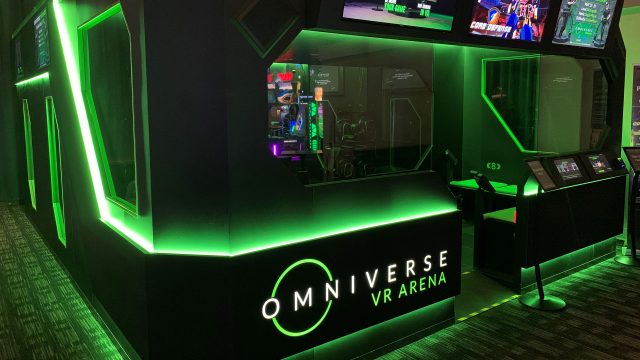
Virtuix realized early on that VR was, at this stage, a fairly clunky proposition. Only early enthusiasts and computer experts had the skills and patience to set up and troubleshoot even consumer VR systems, let alone one that cobbled together complex hardware like a headset and VR treadmill. Expecting arcade attendants to figure out how to keep a system of four Virtuix Omni treadmills, VR headsets, and an array of networked computers powering it all, just wasn’t realistically going to work at scale.
That led the company to build Omni Arena like a giant all-in-one VR arcade. The company has impressively customized literally every step of the customer’s journey through the experience. From the moment they step into the enclosure they’re guided by video screen prompts about what they’re going to experience, how to slip on their special shoes, and how to get into the Virtuix Omni treadmill once it’s their turn.
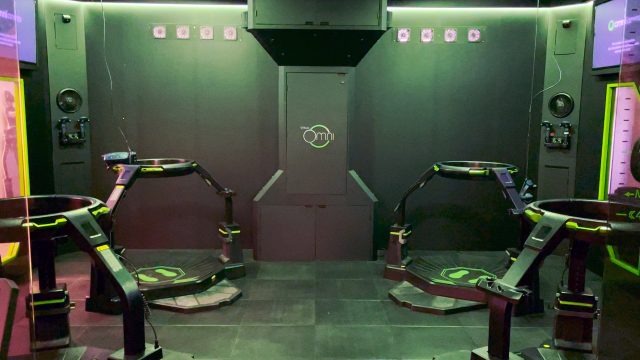
The same, if not more, care has been paid to the operator’s experience. Omni Arena has everything to be a self-sustaining VR attraction. It doesn’t just come with the four treadmills, but also four headsets, controllers (with charging pods), SteamVR tracking base stations, and all the hardware to run the networked VR experiences and the pod’s software itself which not only manages all of the connected devices, but even captures footage of players (both in and outside of the game) and emails it to them as a memento of their experience. It also makes routine troubleshooting steps like headsets, computers, or SteamVR into a simple touchscreen button press through a custom interface for the operator. Omni Arena is truly an all-in-one product.
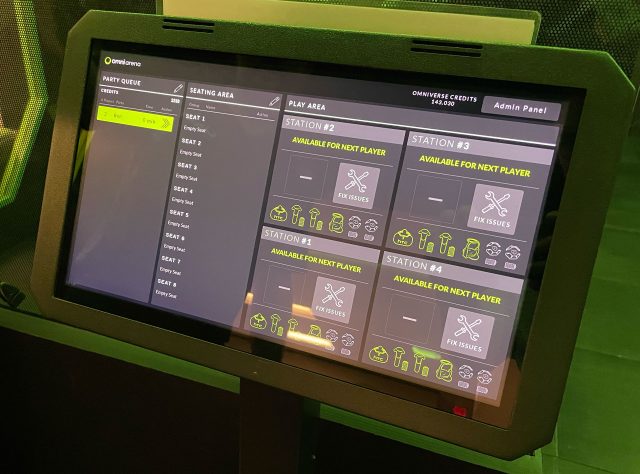
For a small company, Virtuix’s ability to focus on the holistic experience of its product is both rare and impressive.
Coming Full Circle
With the many lessons learned about creating an all-in-one experience for the out-of-home VR attraction space, the company is turning its attention back to the consumer realm with a brand new product—Virtuix Omni One.
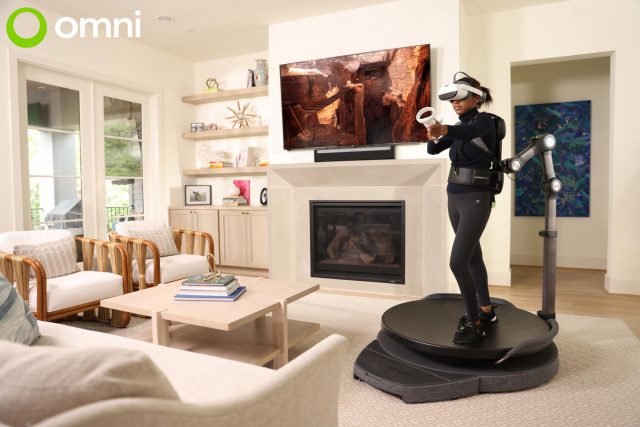
With Omni One, Virtuix isn’t selling a VR treadmill. It’s selling an all-in-one system that includes the newly designed VR treadmill, a VR headset, and access to a library of custom-made content. It’s an ambitious approach, but one that reflects Virtuix’s ability to identify and address key problems with the overall experience it wants to deliver to customers.
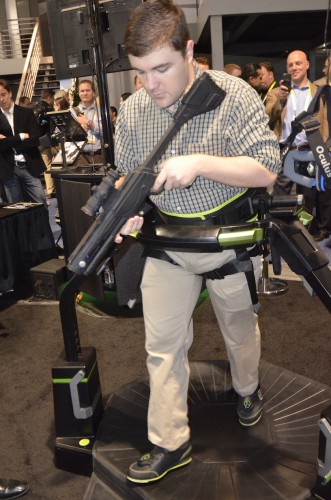
One of those key points the company identified was the way that the original Omni design made compatibility with modern VR content a challenge. The support ring around the player mean their movement was restricted, both in their ability to crouch, lean, and move their arms with complete freedom.
That ‘simple’ problem necessitated a complete redesign of the treadmill. The Omni One now uses an arm support design that always stays behind the user. This gives you the ability to have a full range of motion while also running in any direction. The arm doesn’t actively hold you upright, but it provides the force that prevents you from running straight off the edge of the treadmill.
Another problem the company identified in its goal of delivering a consumer VR treadmill is the complexity of existing PC VR systems and getting players into the right content.
Even if Omni One customer was already an expert in PC VR and willing to put up with technical annoyances, having a tether to the computer means worrying about the user wrapping themselves up in the cable (or asking them to rig up a ceiling mounted cable management system).
Though the Omni One can still technically be used with a PC VR setup, this challenge pushed Virtuix to pair its treadmill with a standalone VR headset out of the box (Pico Neo 3, specifically). But it’s not just a headset, but a headset equipped with a custom-made Omni storefront serving up content that’s specifically made or adapted for the VR treadmill. The company even built its own ‘first steps’ experience, a surprisingly well-made introduction that introduces users to the magic of VR and teaches them how to move and feel comfortable with their controllers and treadmill.
And although sticker-shock has always been a challenge for Virtuix, the Omni One is actually not an unreasonable price… if you think of it as what it truly is: a treadmill that will give you a workout.
Typical exercise treadmills range in price from $500 to $2,000 or more. Omni One will be price at $2,600, including the $700 Pico Neo 3 headset (which the company stresses can also be used as a standard Pico headset (including PC VR streaming). That leaves the treadmill itself at $1,900, the cost of a high-end treadmill. The company is also promising an option to finance the Omni One for $65 per month.
And for those that really believe in Virtuix and its vision, through the company’s crowd-investment campaign it is offering a 20% discount on Omni One (or more, depending upon the amount invested). The campaign has raised $4.4 million to date.
Continue on Page 2: Omni One Hands-on »
,
Omni One Hands-on
On a recent visit to the company’s Austin, Texas headquarters I got to try Omni One for myself. And in speaking with CEO Jan Goetgeluk I came away impressed with Virtuix’s focus on the overall user experience, instead of just building a VR treadmill and hoping that customers will figure out the rest.
Similar to the original treadmill, using the Omni One doesn’t feel entirely like natural walking, but once you get the hang of it it’s functionally pretty comparable. After about 15 minutes strapped into the treadmill I was comfortable walking, jogging, and running, and it wasn’t long after that I felt like I could trust the hardware enough to nearly forget about it and get completely immersed in the game I was playing
The least natural part of the experience is getting used to swinging the arm around behind you as you turn. Even though the arm is fairly light and swivels freely, there’s quite a bit of inertia because of how far it is from your center of gravity. You’ll have to be strapped into the harness quite snuggly and be intentional in getting it to turn when you need it to, but it becomes part of the overall muscle memory pretty quickly.
In my demo I played a modified version of the company’s first-party Elite Force shooter, which was initially built for the company’s VR attraction. The experience was a run-and-gun affair, which had Goetgeluk and I chasing each other around a small arena and shooting with a basic array of weaponry.
Physically running to either chase your opponent or running away from them feels exhilarating and is at times immersive in a way that ‘gliding’ across the ground in other VR games just can’t be. Because I was physically responsible for moving my body out of danger’s way in the game—rather than just holding a thumbstick to go in the direction I want to—it felt very easy to get deeply immersed in the game; sort of like bringing more of my body into the game.
For a 10-minute experience it was a fun romp that left a smile on my face. But upon taking off the headset I quickly realized just how winded I’d become in that short period of time. I’m a reasonably fit person—according to my FitBit, my cardio is considered “good to very good” for men my age—but it was very apparent to me that this was a workout as much as a game.
Because of the way Omni One works—where you slide your feet on a slippery (but not frictionless) surface—every gait feels like it goes up one effort level. That is to say: walking feels like jogging, jogging feels like running, and running feels like sprinting.
Even in my short time with the treadmill, it became apparent to me that in order for Omni One to succeed it will be essentially to pair it with content that very carefully takes the player’s physical exertion into consideration.
While Elite Force essentially encouraged me to run continuously, if Virtuix wants people to use the treadmill for more than 30 minutes before completely wiped, they’re going to need to focus on content that very thoughtfully modulates the player’s movement speed with a combination of mostly walking, occasional jogging, and only rarely full-blown running.
Similarly, while the company’s game development talent is actually pretty impressive for a company that’s known primarily for its hardware, the arcade-focused roots of Elite Force were still very apparent and felt like it was missing the kind of depth I’d want to see in a VR experience that would bring me back time and again.
In sharing this feedback with Goetgeluk and the team, I was assured that Elite Force is still very much in beta, and has essentially only just been ported over from the original version that was built for short quick and easy arcade experiences. More changes are coming, and not to mention a handful of other first-party content (and other types of content) that will bring more varied experiences and more varied amounts of exertion.
In the end: content is king.
Omni One’s hardware might not replicate a perfectly natural giat—but I think it’s good enough to deliver on the promise of being able to bring your body into the experience in a way that’s meaningfully different than using a VR headset while sitting or standing. Virtuix has also done a good job building the device to offer a full range of motion that’s essential for modern VR games.
With the hardware sufficiently covered, great content—especially content that’s thoughtful of exertion—is going to be the thing that makes or breaks Omni One.
At the outset the company is promising some 30 titles that will be compatible with treadmill by the end of the year. That’ll be a combination of some first party content, but most of it will be existing content from third-party VR developers that has been adapted for Omni One; though exactly how much those games will be modified to specifically consider the treadmill’s unique challenge (ie: ‘exertion design’) is unclear.
If this were a less experienced company I’d be more worried that the creators wouldn’t fully appreciate that content is the lynchpin of the product. But considering the multi-domain challenges that Virtuix has demonstrated it can overcome up to this point, I think they’re better suited that most to rise to the challenge.
But we’ll have to wait and see how it pans out. There’s clearly still more work ahead for the company on the content front. Omni One ‘beta’ units are shipping to participants of the company’s crowd-investment campiang, and the company’s goal of having generally available units early next year is fast approaching.
Disclosure: Virtuix assisted with travel expenses for a visit to the company’s Austin headquarters.
